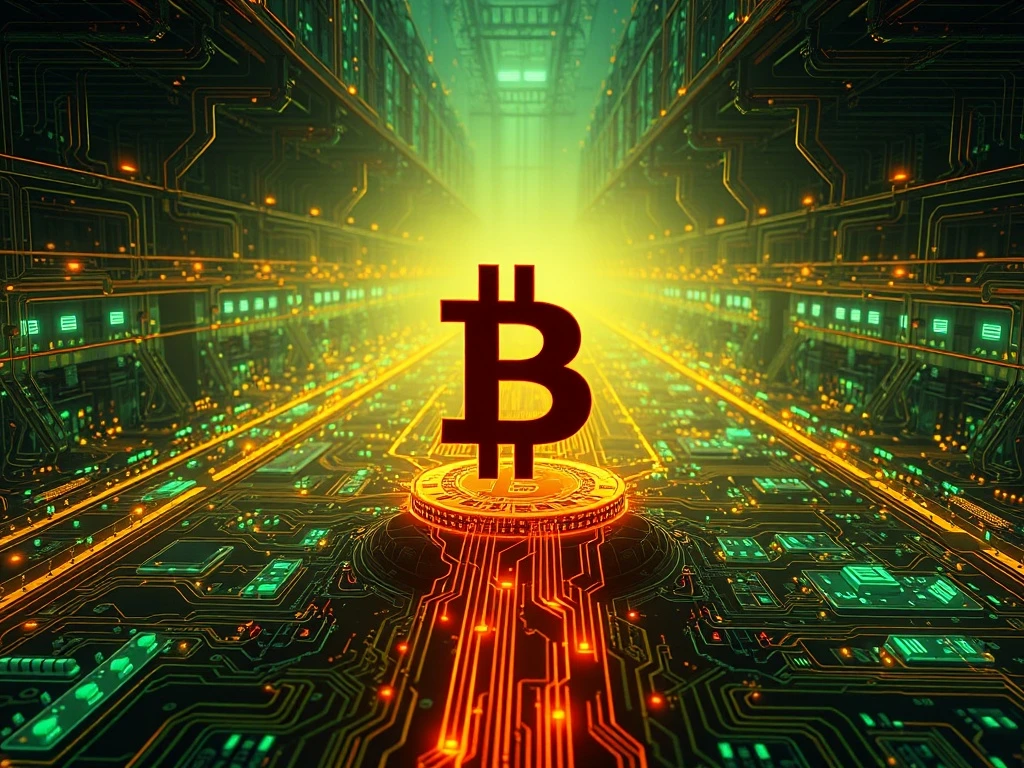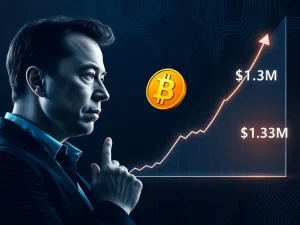Astonishing Solo Bitcoin Miner Claims $373K Block Reward Against All Odds

Imagine striking gold in a digital age. For one lucky individual, this dream became a reality. A solo Bitcoin miner recently achieved an astonishing feat, securing a $373,000 block reward in a network dominated by industrial giants. This remarkable success captured the crypto community’s attention, proving that even in a highly competitive environment, individual persistence and a dash of luck can still lead to monumental wins. It highlights the enduring spirit of decentralization that defines Bitcoin.
The Astonishing Solo Bitcoin Miner Win
On July 26, 2025, a single solo Bitcoin miner made headlines. This individual successfully mined block 907,283 through the Solo CKPool, overcoming incredibly steep odds. Consequently, they claimed the full block reward of 3.125 Bitcoin (BTC), valued at approximately $372,700. This block also included an additional $3,400 in transaction fees from its 4,038 transactions. This event served as a powerful reminder: despite the corporatization of the mining market, small players still possess a chance at significant glory.
The success occurred as Bitcoin’s network difficulty hovered near all-time highs, around 26 trillion. This makes solo success increasingly unlikely, yet the miner beat millions of competitors. Their sheer persistence and a bit of luck made this one-in-a-million win possible. Furthermore, it underscored Bitcoin’s foundational design, where even the smallest participant can contribute to network security and earn substantial rewards.
How Solo CKPool Works: Empowering the Individual
Solo CKPool offers a unique solution for those who want to engage in solo Bitcoin mining without managing all the technical infrastructure themselves. Unlike traditional mining pools, which distribute rewards proportionally to hash power, Solo CKPool operates differently. It grants the entire block reward to the individual miner who successfully finds a block. However, if you do not find a block, you earn nothing.
This model effectively mimics true solo mining. Nevertheless, it benefits from the stability and superior connectivity provided by the CKPool operator’s infrastructure. This setup allows small-scale miners a shot at full rewards, even though the odds remain long. It represents a high-risk, high-reward strategy, perfect for those who understand the low probability but desire the potential payout of 3.125 BTC in a single hit. Miners can track their statistics and block status using platforms like solostats.ckpool.org and mempool.space. These tools verify whether a miner has submitted a valid block. Occasionally, someone does, just like the solo miner who cracked block 907,283, proving its viability.
Did you know? Satoshi Nakamoto mined the first Bitcoin block, the “Genesis Block,” on January 3, 2009. It contained a hidden message referencing a newspaper headline, confirming it wasn’t pre-mined and marking the birth of decentralized money.
The Unlikely Odds of Solo Bitcoin Mining Success
Solo Bitcoin mining is incredibly challenging in today’s hyper-competitive environment. The global network hashrate currently sits around 902 exahashes per second (EH/s). Moreover, mining difficulty has surpassed 127 trillion. Industrial-scale operations overwhelmingly dominate the field. To put it into perspective, a miner with 1 petahash per second (PH/s) faces roughly a one-in-4.26 million chance of solving a block on any given day. For context, you are statistically far more likely to be struck by lightning than to mine a block solo at that rate.
This sheer statistical unlikelihood makes solo wins exceptionally rare in 2025. Yet, they continue to happen. When they do, these triumphs remind everyone that Bitcoin was fundamentally built for decentralization. In this system, even the smallest player can walk away with the full block reward and associated transaction fees. This possibility fuels the dreams of many aspiring solo miners worldwide.
Remarkable Block Reward Wins by Solo Miners in 2025
A handful of solo Bitcoin miners have defied the odds in 2025, achieving wins that sent ripples across the entire crypto mining community. For instance, in February, one miner solved block 883,181. This individual consequently pocketed the full 3.125 BTC reward, which was worth around $300,000 at the time. March and June brought similar success stories, showcasing the persistent possibility of individual triumph.
One notable success involved a miner using a modest 480 gigahash-per-second Bitaxe rig. This low-power, DIY device successfully mined a full block. In contrast, large mining firms typically operate hardware rated at over 230,000 GH/s. On June 5, another solo miner validated block 899,826 through the Solo CKPool. They earned a reward of $330,386, which included 3.125 BTC from the block subsidy and 0.026 BTC in fees. This block contained 3,680 transactions, and the network difficulty stood at 126.98 trillion. These examples highlight that while difficult, winning the block reward is not impossible.
Did you know? The famous 10,000-BTC pizza purchase in 2010 likely originated from early mining rewards. At that time, each block paid out 50 BTC. Coins were often traded or given away casually, long before they had any real market value.
The Mechanics Behind These Crypto Mining Triumphs
Solo Bitcoin miners continue to demonstrate that efficient hardware, unwavering persistence, and a bit of luck still yield significant payouts. Their victories effectively keep the spirit of decentralization alive. Several factors contribute to these rare successes:
- Application-Specific Integrated Circuits (ASICs): These purpose-built machines deliver high computing power with minimal energy consumption. ASICs provide small-scale miners a fighting chance, especially when combined with platforms like Solo CKPool. Nevertheless, solo mining involves high risk; most attempts go unrewarded. However, every once in a while, a miner solves a block and earns the full payout. These rare wins continually motivate miners chasing that one big success.
- Core Principles of Bitcoin: Solo mining victories accomplish more than just rewarding persistence; they powerfully demonstrate Bitcoin’s foundational ideals. These moments prove that anyone, anywhere, can help secure the network without permission. Each successful block highlights Bitcoin’s open and decentralized design. Simply put, solo wins serve as reminders of the individual’s power within a global network, in a system built for inclusion.
- Persistence and Luck: Technical upgrades only go so far; persistence and luck ultimately shape the outcome. Even with ASICs running nonstop, most solo miners understand the odds are stacked against them. Yet, they persevere, driven by the belief that one valid hash could change everything. In that sense, every win is partly a triumph, partly a testament to endurance.
Platforms like Solo CKPool make it possible for individuals to engage in crypto mining without joining a large corporate setup. Most solo attempts do not result in a payout, but sometimes, luck aligns, and a miner walks away with the full block reward.
Did you know? When Bitcoin launched in 2009, each block paid 50 BTC. The reward halves approximately every four years: 25 BTC in 2012, 12.5 BTC in 2016, 6.25 BTC in 2020, and 3.125 BTC in 2024. This steady reduction ensures scarcity, capping the total supply at 21 million.
Navigating Industry Pressures in Bitcoin Mining
Solo Bitcoin miners achieved some rare wins in 2025 despite growing industry pressures. Rising costs and fierce competition force even large operations to rethink their strategies. In this context, these solo victories, often powered by modest hardware, truly stood out. They captured the community’s attention, reminding everyone that bitcoin mining still leaves room for long shots and surprising outcomes.
- Rising Costs and Industry Challenges: In Q2 2025, the average cost to mine 1 BTC exceeded $70,000. This increase was driven by a global hashrate approaching 1,000 EH/s and a mining difficulty surpassing 126 trillion. Corporate miners face tight profit margins, prompting efforts to optimize energy use and secure affordable power sources.
- Strategic Industry Shifts: Major mining firms are diversifying into AI data centers and high-performance computing. These moves aim to counter declining profitability. Such strategies benefit from existing infrastructure, seeking more stable returns. This reflects a broader strategic transformation within the crypto mining industry.
Despite these significant challenges, solo miners with modest rigs continue to secure rare wins. These moments highlight Bitcoin mining’s unpredictable nature. They also prove that persistence and luck still play crucial roles in this high-stakes game. Ultimately, these solo triumphs reinforce Bitcoin’s core value proposition: an open network accessible to all.









